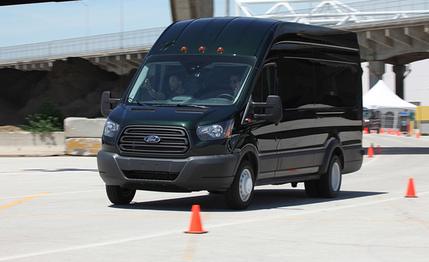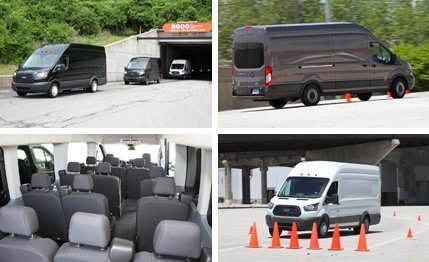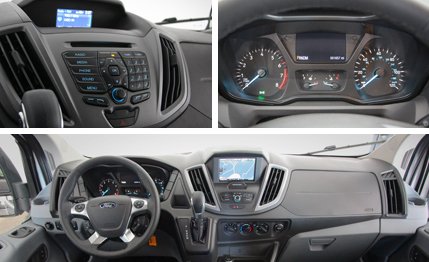 First Drive Review
First Drive Review
For anyone who’s spent time at the helm of a Ford Econoline/E-series over the decades, there have been many things to deal with: a steep climb into the cabin, oceans of featureless plastic dash and door trim, truly awful seats, and under the hood, wheezy V-8 and V-10 engines that were more thirsty than thrusty. But archaic as it was, the E-series got the job done. So you dealt with it.
These are all things you will not have to contend with in the new Ford Transit, which replaces the venerable E-series in dealerships starting this July. Already in production at Ford’s Kansas City assembly plant, the Transit is essentially the same Euro-style box on wheels that’s sold in more than 100 other markets worldwide. It’s one of the many happy results of Ford’s globalization efforts that also produced our current Fiesta, Focus, Fusion, and, of course, the Transit’s little brother, the Transit Connect.
Take Your Seats
The Transit is not much to look at, particularly in the taller-roof varieties that visually dwarf the button-nose snout, and it’s so flat on every side that an Econoline looks like a ’68 Corvette by comparison. But if the Transit is low on passion, it’s high on functionality—perfect for most van customers. It can be ordered in endless combinations, with two available wheelbase lengths, three body lengths, and three roof heights, the largest of which contains more than 487 cubic feet of cargo space—75 percent more than in the largest E-series. As on the Mercedes-Benz Sprinter, inboard-mounted dual rear wheels are available, which in the Ford’s case add four inches of overall width. Ford expects that 24 percent of all Transits will be sold as passenger wagons, with seating for 8, 10, 12, or 15, compared with a maximum of 12 in the Sprinter and, well, just two in the cargo-only Ram ProMaster. In its most potent forms, the Ford can pull a 7500-pound trailer and haul 4650 pounds of your business’s business. The point is you can have it your way.

There is plenty more to appreciate inside the Transit. The seats are supportive and covered with a durable fabric or real leather. (Yes, leather seats in a cargo van!) An optional rear camera makes parking and/or mounting a trailer a relative breeze, and the fully functional MyFord Touch infotainment system brings heretofore unimagined technology and convenience to the full-size-van market. The steering wheel doesn’t quite come down low or vertical enough to feel anything but buslike, but the same can be said about the ProMaster and Sprinter.
It doesn’t take much skill to drive the Transit around town. Although you can’t see the vehicle’s hood, the huge windshield, the low side glass, and the slab sides impart a reasonably good sense of the van’s location within its lane. We drove many versions, from passenger models to cargo models—the latter with half their respective maximum payloads strapped in the back—and each felt remarkably planted, with a stunning lack of body roll. It doesn’t take too much to overwhelm the front tires in corners, but the Transit’s aggressive (and not defeatable) stability control puts a quick stop to any shenanigans. The steering is heavily boosted and a little slow off-center, but it has none of that old-van vagueness that plagued the Econoline. An available lane-keeping alert system vibrates the steering wheel to warn drivers of lane drift, although it is not available with a crosswind-compensation system like the Sprinter’s.
Under the Hood
Unlike Transits sold elsewhere in the world, which can be had with front-, rear-, or all-wheel drive, all Transits sold here are rear-drivers. Motivation is provided by a 3.7-liter V-6 with 275 horsepower and 260 lb-ft of torque, a twin-turbocharged EcoBoost 3.5-liter V-6 with 310 horses and 400 lb-ft of torque, or a 3.2-liter Power Stroke inline-five turbo-diesel with 185 horsepower and 350 lb-ft of torque. All engines are mated to a six-speed automatic with rocker-switch manual shift control. On paper, the base V-6 and the diesel are competitive with the best available engines in the ProMaster and Sprinter. We’ll have to test them to see if the numbers pan out, but in any case, the EcoBoost model is Ford’s trump card.

After sampling each engine, we came away impressed, particularly with the gas mills. Whereas diesels are usually the go-to motors in any utility vehicle’s powertrain lineup, the Transit’s base 3.7-liter V-6 feels more than up to snuff, even with the aforementioned added poundage Ford loaded in each van for our drives. Stepping up to the diesel brings extra muscle for the heavier vans, but the one to get, we think, is the EcoBoost V-6, which does just as remarkable a job here (with that happy turbo whoosh) as it does in the F-150 pickup truck. Even better, it does so without sapping even a single mpg of EPA-rated fuel-efficiency: both V-6s achieve 14/19 city/highway ratings, some 19 percent better than the E-series’ base V-8 and a huge 46 percent better than the V-10. We look forward to driving a Transit completely empty, but even with all the extra weight in the back of the cargo vans—or the extra seats in the wagon, which can add up to 920 pounds in the case of the 15-passenger model—we never felt as if we were holding up traffic when pulling away from a stoplight.
Transit prices start just north of $30,000, a few grand higher than the cost of a ProMaster and a bit more than the E-series it replaces. Upgrading to the diesel or the turbo V-6, the heavier-duty models, and premium options can take the price over $50,000 without much effort, but in most cases, the Transit remains considerably cheaper than a comparably equipped Sprinter, and we have no doubt Ford offers highly competitive fleet rates.
The Transit might not look pretty, but with its combination of utility, fuel efficiency, and cabin comfort, we expect its customers will find it shines from within.